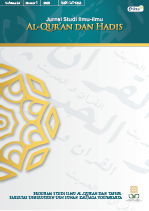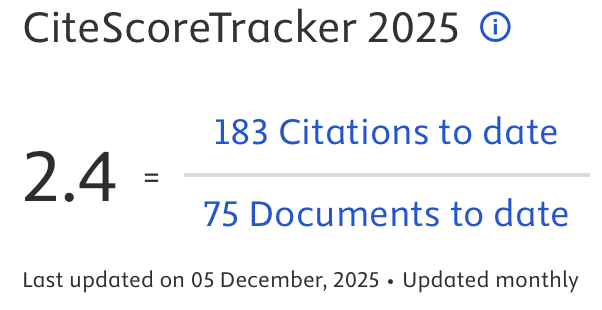Modern Arts of the Qur’an and its Aesthetic Reception of the Qur’anic Marble Inscription in Indonesia
DOI:
https://doi.org/10.14421/qh.v24i1.4020Keywords:
Aesthetic Reception, Qur'anic Lithography, Marble Qur'an, Modern ArtAbstract
This article explores the aesthetic reception of the modern marble inscription of the Qur'an and its underlying meaning. The study uses field research and locates its research locus at Masjid Al-Muhtaram, Kajen, Pekalongan Regency where the marble stone is kept. The research adopts Wolfgang Iser's reception theory to analyse the meaning of the marble stone Al-Qur'an from an aesthetic standpoint. The results show that the marble stone inscription of the Qur'an was made by Nur Hidayat Siba, starting in 2011 until 2021, and has reached 13 juz of the Qur'an. The marble measures 60 x 90 cm with a thickness of 2 cm, and is written with beautiful khat and gold colour wrapping on every khat. The inscription provides three meanings of aesthetic reception. Firstly, the objective meaning of the Qur'an as a holy book must be preserved through beautiful media as a form of appreciation for the greatness of the Qur'an. Secondly, the expressive meaning is used as a medium of Islamic da'wa, and spirituality increases faith and religious aspects for those who see and read it. Finally, the meaning of documentary serves as a form of habitus to always interact with the Qur'an in everyday life. These three meanings illustrate the diversity of meanings in the aesthetic reception of the marble Al-Qur'an. The study contributes to the body of knowledge by shedding light on the significance of aesthetic reception of the Qur'an and highlights the importance of preserving the holy book through beautiful media.
 Abstract viewed: 794 times
|
Abstract viewed: 794 times
|
 PDF downloaded = 561 times
PDF downloaded = 561 times
References
Abshor, M U. “Resepsi Al-Qur’an Masyarakat Gemawang Mlati Yogyakarta.” Qof 3, no. 1 (2019).
Al-Baihaqi, Riyas. Agus Noto, Direct Interview. Pekalongan, 2021.
Al-Qurtubi, S. Al-Jami’ Lii Ahkaam Al-Qur’an (XVII. Riyadh: Dar Alam al-Kutb, 2002.
Amin, M. “Resepsi Masyarakat Terhadap Al-Quran (Pengantar Menuju Metode Living Quran).” Jurnal Ilmu Agama 21, no. 2 (2020).
Baidowi, Ahmad. “Aesthetic Reception of the Qur’an”.” Journal Esensia 8, no. 1 (2007): 20.
Blair, Sheila S. Islamic Inscriptions, Washington Square. New York University Press, 1998.
Fadlillah, N. “Resepsi Terhadap Alquran Dalam Riwayat Hadis.” Nun 3, no. 2 (2017): 103.
Fathurrosyid. “Tipologi Ideologi Resepsi Al-Quran Di Masyarakat Sumenep Madura.” El Harakah 17, no. 2 (2015).
———. “Typology of Al-Quran Reception Ideology in Sumenep Madura Society”.” Journal El Harakah 17, no. 2 (2015): 220.
Gade, Anna M. The Qur’an: An Introduction. Oxford: Oneworld Publications, 2010.
Haris, Tawalinuddin. “Inskripsi Ashabul Kahfi Pada Mihrab Masjid Agung Surakarta”.” Shuhuf 5, no. 1 (2012): 98.
Iser, Wolfgang. The Act of Reading: A Theory of Esthetic Response. The John Hopkins University Press, 1978.
Jannah, M. “Musabaqah Tilawah Al-Qur’an Di Indonesia (Festivalisasi Al-Qur’an Sebagai Bentuk Resepsi Estetis.” Jurnal Ilmu Ushuluddin 15, no. 2 (2016).
Kermani, Navid. Gott Ist Schön Das Aesthetische Erleben Des Koran. CH Beck, n.d.
Khosim, M. “Resepsi Estetis Qur’ani Dalam Musik Rock Sholawat Rofa Band Di Bantul Yogyakarta.” Jurnal Studi Ilmu-Ilmu Al-Qur’an Dan Hadis 20, no. 2 (2019): 187–202.
Kuswarini, P. “Penerjemahan, Intertekstualitas, Hermeneutika Dan Estetika Resepsi.” Jurnal Ilmu Budaya 4, no. 1 (2016).
Lukman, F. “Epistemologi Intuitif Dalam Resepsi Estetis H.B. Jassin Terhadap Al-Qur’an.” Journal of Qur’an and Hadith Studies 4, no. 1 (2015).
Mahmood, Shaukat. “Epigraphy in Pakistan Mosques”.” Hamdard Islamicus 8, no. 2 (1985): 71–89.
Masrurin, A. “Resepsi Alquran Dalam Tradisi Pesantren Di Indonesia (Studi Kajian Nagham Alquran Di Pondok Pesantren Tarbitayul Quran Ngadiluweh Kediri.” Al-Bayan: Jurnal Studi Al-Qur‘An Dan Tafsir 3, no. 2 (2018): 101–118.
Muttaqin, A. “Resepsi Estetis H.B. Jasin Terhadap Ayat Metafora Dalam Bingkai Teori Kritik Sstra.” Suhuf 10, no. 2 (2017): 307–326.
Nasr, Seyyed Hossein. Islamic Art and Spirituality. Lahore: Sauhail Academy, 1997.
Nurfuadah, H. “Living Quran: Resepsi Komunitas Muslim Pada Alquran (Studi Kasus Di PP. At-Tarbiyyatul Wathoniyyah Desa Mertapada Kulon, Kec.” Astatana Japura, Kab. Cirebon). Diya Al-Afkar 5, no. 1 (2017).
Pahala, A A. “Aesthetic Reception on Sakban Yadi’s Calligraphy Painting”.” Journal Tarbiyatuna 9 (2018): 3.
———. “Resepsi Estetik Pada Lukisan Kaligrafi Sakban Yadi.” Tarbiyatuna 9, no. 1 (2018): 3.
Purnama, Rizal Faturohman. “The Aesthetic Reception Of The Quran In Instagram: Variations, Factors, and Religious Commodification”.” Journal Ulul Albab 21, no. 2 Tahun (2020): 240.
Rafiq, Ahmad. “Atomistic Reading of the Qur’an; Between Deviations and Functions”.” Journal of the Study of the Qur’an and Hadith 4, no. 1 (2004): 3–5.
———. “History of the Qur’an: From Revelation to Reception (An Early Methodological Search)".” Journal Islamic Traditions and Civilizations (2012).
Riani, A. “5 Unique Al-Qurans in Indonesia, Made from Marble to Gold Ink”,” 2019. liputan6.com.
Riyadi, F. “Resepsi Umat Atas Alquran: Membaca Pmikiran Navid Kermani Teori Resepsi Alquran.” Hunafa 11, no. 1 (2014): 43–60.
Setiawan, M.Nur Kholis. The Greatest Book of Literature Koran. Yogyakarta: eLSAQ Press, 2006.
Siba, M.Hidayat Nur. Direct Interview. Pekalongan, 2021.
Subhan, Ahmad. “Percetakan Al-Qur’an Palembang 1848 Dalam Lintasan Budaya Cetak Abad Ke-19”.” Suhuf 14, no. 1 (2021): 203.
Sukarno, S. “The Beauty of the Al Quran Made of Marble at the Al Muhtarom Pekalongan Mosque”.” central java Inews, 2021.
Zaman, A R B. “Resepsi Al-Qur’an Di PP. Al-Hidayah Karangsuci Purwokerto.” Maghza 4, no. 1 (2019).
Downloads
Published
How to Cite
Issue
Section
License
Copyright (c) 2023 Shinta Nurani, Luthfi Maulana

This work is licensed under a Creative Commons Attribution-NonCommercial-NoDerivatives 4.0 International License.
Publishing your paper with Jurnal Studi Ilmu-ilmu al-Qur'an dan Hadis means that the author or authors retain the copyright in the paper. Jurnal Studi Ilmu-ilmu al-Qur'an dan Hadis uses license CC-BY-NC-ND or an equivalent license as the optimal license for the publication, distribution, use, and reuse of scholarly works. This license permits anyone to copy and redistribute the material in any medium or format and must give appropriate credit, provide a link to the license, and indicate if changes were made. If you remix, translate, transform or build upon the material you may use it for private use only and not for distribution. Jurnal Studi Ilmu-ilmu al-Qur'an dan Hadis granted an exclusive non-commercial reuse license by the author(s), but the author(s) are able to put the paper onto a website, distribute it to colleagues, give it to students, use it in your thesis, etc, so long as the use is not directed at a commercial advantage or toward private monetary gain. The author(s) can reuse the figures and tables and other information contained in their paper published by Jurnal Studi Ilmu-ilmu al-Qur'an dan Hadis in future papers or work without having to ask anyone for permission, provided that the figures, tables, or other information that is included in the new paper or work properly references the published paper as the source of the figures, tables or other information, and the new paper or work is not direct at a private monetary gain or commercial advantage.
Jurnal Studi Ilmu-ilmu al-Qur'an dan Hadis journal Open Acces articles are distrubuted under the Creative Commons Attribution-NonCommercial-NoDerivatives 4.0 International (CC BY-NC-ND 4.0). Article can be read, copy and redistribute the material ini any medium or format under the following conditions:
Attribution — You must give appropriate credit, provide a link to the license, and indicate if changes were made. You may do so in any reasonable manner, but not in any way that suggests the licensor endorses you or your use.
NonCommercial — You may not use the material for commercial purposes.
NoDerivatives — If you remix, transform, or build upon the material, you may not distribute the modified material.










